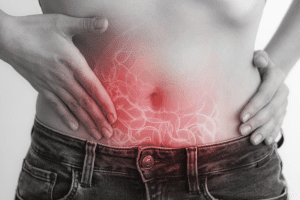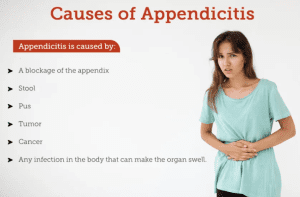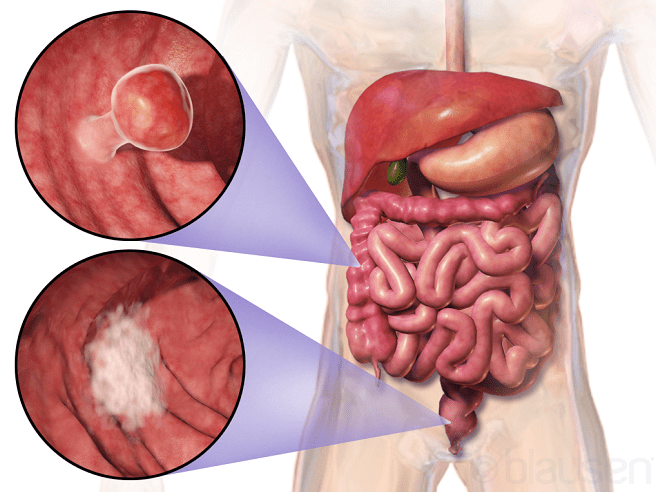Symptoms of Appendicitis: Appendicitis is an emergency condition in which the appendix is heated and causes severe pain in the lower right side of the abdomen. The appendix is a narrow tube-like organ attached to the sacrum, which is a part of the large intestine. It is located on the lower right side of the abdomen (the area between the chest and the pelvis). The exact role of the appendix in our body is unknown, but among other animals, it helps digestion.

In addition, people with appendicitis experience other symptoms, such as vomiting, fever, and lower back appendicitis pain. To diagnose the disease, doctors look for signs and symptoms, perform a clinical examination, and if necessary, the doctor will recommend an ultrasound, lab tests, or CT scans.
Appendectomy is a surgical procedure where a cut or hole is made in the lower abdomen to remove the appendix. In some cases, antibiotic therapy is also used. When the narrow tube of the appendix gets stuck in the stool or food, it can explode and the contents can spread to the surrounding pituitary tissue that can cause an infection. In any such case, it is important to control the infection in a timely manner.
Also Read – Malaria: Malaria Symptoms, Causes, And Treatment
What is Appendicitis?
Appendicitis is a medical emergency condition that can occur at any age but, it is more common in people aged 10-30. It is a painful swelling or inflammation of the appendix, a small, tubular or finger-like organ that extends from the colon. The mouth of the appendix is small, for some reason particles of food and waste material stored in it, and sometimes it can create a barrier. This barrier can lead to a bacterial infection, that’s called Appendicitis.
If the appendix explodes at this stage, and if not treated in time, it can spread bacterial infections to the pituitary cavity that can be life-threatening. When the appendix is heated, you may feel pain in your abdomen (which comes and goes). The pain gradually intensifies and persists.
It is fixed to the lower right where the appendix is located. Walking, coughing, or pressure on the abdomen can make the pain worse. Fever, loss of appetite, and upset stomach are also sometimes associated with appendicitis.
Read About 123Movies
Types of Appendicitis:
There are two types of appendicitis depending on the onset, these are Acute Appendicitis and Chronic Appendicitis. And depending on the complications there are also two types of appendicitis, which are Simple Appendicitis and Complex Appendicitis.
Watch Solarmovie
Appendicitis Symptoms:
Appendicitis is a common disease, and there are several signs and symptoms of appendicitis. It can happen to people of all ages including appendicitis in children. However, it is usually seen in the age group of 10 to 20 years. If you have appendicitis, you will start having pain in the middle of your lower abdomen. Many times appendix pains can appear and disappear.

Within a few hours, the appendix pain goes to the lower right of the lower abdomen, where the appendix is located. The pain escalates and didn’t stop. Pressure, coughing, or walking can make the pain worse. There may be some more signs of appendicitis along with the pain.
- Anorexia can be reduced.
- May cause cough.
- May cause constipation.
- May cause fever.
- Flatulence
- Diarrhea
- Shivering in the cold
- There may be side pain in the body.
- Body temperature may rise and the face may turn red.
These symptoms are also common in Appendicitis in kids.
When to go to the doctor: If you have pain in your lower abdomen and the pain continues to increase over time, then consult with a doctor immediately. But remember due to symptoms of other diseases similar to appendicitis, we miscalculate it with appendicitis.
Those are:
- Vomiting and diarrhea
- Irritable Bowel Syndrome (IBS)
- Constipation
- Bladder or urinary tract infections
- Pelvic infection
In some cases, some gynecological diseases in women can cause symptoms like appendicitis. But for whatever reason, if you have lower abdominal pain, you should talk to a doctor immediately. If your pain suddenly increases sharply and spreads to the entire lower abdomen, or the pain subsides for a while, call an ambulance immediately. When the appendix bursts, the pain decreases for a while and increases. Peritonitis can occur if the appendix bursts. It is a deadly infection that can lead to death.
Also Read – Anemia: Symptoms, Causes And Treatments of Anemia
What Causes Appendicitis?
Appendicitis is caused by obstruction inside the appendix, which causes bacteria to multiply rapidly, causing the appendix to swell and begin to accumulate. If not treated quickly, the appendix may rupture and kill the patient.

Diagnosis of Appendicitis:
It is very difficult to diagnose if you do not have common symptoms of appendicitis. Half the time a person with appendicitis does not have these symptoms. Also, some people’s appendix is located in a slightly different position of the body. Like,
- In the pelvis.
- Behind the colon.
- Around the small intestine.
- In the lower right of the liver.
Some people have pain like appendicitis. However, it may be due to some other reasons. Like, diarrhea, Irritable Bowel Syndrome (IBS), Constipation, Bladder, or urinary tract infections.
Due to these reasons, It is difficult to understand whether appendicitis has occurred or not. If you go to the doctor, he or she will want to know your symptoms, examine your lower abdomen, and see if the pressure around the appendix (lower right of the lower abdomen) increases the pain.
If you have common symptoms of appendicitis, your doctor will usually tell you if you have appendicitis. In this case, you will be sent to the hospital for treatment immediately.
Also Read – 14 Ashwagandha Benefits, Uses, Doses, and Side Effects
Appendicitis Test:
If you do not have the common symptoms of appendicitis, you may need to do some tests:
- Blood tests can be done to see if you have an infection.
- Women may be tested for pregnancy.
- A urine test can show if you have a bladder infection or something like that.
- An ultrasound scan can show if your appendix is swollen.
- Also, CT scan can be done.
It may take some time to get the results. After doing these, it will be understood that your pain is due to appendicitis or some other reason. Even after doing the above tests, it is not clear if you have appendicitis. In this case, you may be advised to remove the appendix without the risk of appendix burst.
You may also be asked to wait 24 hours to see if your symptoms are getting better. If the doctor thinks your appendix has burst, you will be sent to the hospital immediately.
Also Read – Hemorrhoids or Piles: Hemorrhoids Symptoms, Causes and Treatment
How to Prevent Appendicitis?
The following tips can prevent appendicitis:
- Do not take any antibiotics unless your doctor prescribes them.
- If you still have a fever, keep a record of your body temperature every 2 hours. Bring it with you when you see your doctor.
- Do not use painkillers. It can be difficult to tell if appendicitis is getting better or worse if you take pain medication.
- If you go for a health check-up, do not drink or eat anything.
- Do not use laxatives or enemas. Otherwise, the risk of a torn appendix can increase.
- Get plenty of rest and get enough sleep.
- Avoid putting pressure on your abdominal muscles and do not lift heavy objects.
- Include more fiber in your diet as it will help prevent constipation and make bowel movements easier.
- Drink plenty of fluids every day.
Appendicitis Treatment:
Once appendicitis is identified appendicitis surgery is the best treatment. Once appendicitis is confirmed, surgery is the treatment of choice. Immediate surgery reduces the chances of appendix rupture. The surgical term for appendix removal is called appendectomy.
Appendicitis Surgery:
Depending on each area of appendicitis, the following methods may be applied to perform an appendectomy:
Laparoscopic Surgery:
This is the most preferred method as it takes relatively less time to heal. In this surgery, a flexible tube with special equipment and an attached camera is used to locate and remove the appendix through a few small holes in the abdomen.
Also Read – Arthritis: Types of Arthritis, Symptoms and Treatment
Laparotomy:
In this surgery, the doctor makes only one hole to remove the appendix. A cut is made on the lower right side of the abdomen. Peritonitis – This procedure is more desirable if there is an infection of the lining of the abdominal cavity.
Open Surgery:
Open surgery is performed instead of laparoscopic surgery when
- The person with appendicitis has undergone pelvic surgery before.
- In the appendix, a lump called the appendix mass has grown.
- The appendix is torn.
Antibiotic Therapy:
According to some studies that have compared the different results of different surgeries and antibiotic treatments, 70% of appendix cases are solved by antibiotics, without the need for any surgery. Antibiotics are usually given to those people who are too weak to handle any surgery.
Also Read – Eczema or Atopic Dermatitis: Eczema Symptoms, Causes and Treatment
If possible before an appendectomy, cephalosporins IV antibiotics are applied. If the appendix ruptures, the pus is immediately removed and antibiotics are applied until the patient’s white blood cell count and body temperature return to normal.
Final Words:
If you suspect that you have appendicitis, then you should go to the doctor without delay. Because if this is not treated at the right time, the appendix can burst and germs can spread to the abdomen. This is known as peritonitis. In the case of appendicitis, painkillers, antacids or hot pads cannot be used without the advice of a doctor, as it can cause serious danger to the appendix.






